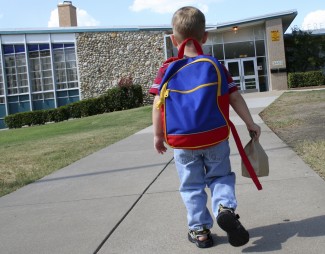This post is the second in a series focused on the energy efficiency implications of the COVID-19 pandemic and a safe, sustainable recovery. The first post explored ways to reduce transmission risks in buildings without wasting excess energy.
Communities across the country are grappling with how and when kids can safely return to school after the long—and, for those of us with school-age children—challenging period of distance learning. These communities and those where schools have reopened have great concern about improving the safety of school buildings in light of COVID-19 and preparing for future disease outbreaks.
The good news is that schools and policymakers can take steps now to create safe, sustainable learning environments that could deliver long-term energy savings. Indeed, some efforts are already underway. As the pandemic continues to delay school reopening or causes reopened schools to close again, there is an opportunity to make much-needed investments to upgrade and replace HVAC systems while schools are unoccupied.
What can schools do?
Schools can follow guidance developed by ASHRAE and the Centers for Disease Control and Prevention (CDC) for safely reopening and maintaining their facilities. This guidance, including a set of checklists, generally aligns with the recommendations outlined in our prior post, but with some considerations specific to schools:
- Develop and enforce mitigation strategies such as social distancing, wearing masks, hand washing, and cleaning tailored to the school, student age group, and staff/faculty needs.
- Modify operating procedures to meet reduced occupancy levels, alternate schedules, and revised cleaning and sanitation routines.
- Retrofit or upgrade building systems to meet the latest guidance for adequate ventilation, filtration, and HVAC operations.
- Create or designate an isolation space such as a nurse’s suite or office for students who develop symptoms while at school. Ideally, it can be outfitted to operate in isolation mode with a dedicated 100% outdoor air system.
In addition, upgrades to building systems can also be an opportunity to improve system energy efficiency.
Schools already face challenges
The need to improve HVAC systems in response to COVID-19 comes at a time when school facilities are already grappling with an enormous backlog of projects to address deferred maintenance and overdue capital improvements. A recent study by the federal General Accountability Office estimates that as of late 2019, HVAC system replacements and upgrades are needed in as many as 45,000 schools across the United States.
Even before the pandemic, outdated, underperforming, or non-functional HVAC systems contributed to uncomfortable, and sometimes extreme, temperature conditions, poor indoor air quality associated with mold and mildew, and the need for school closures or early dismissals. The GAO study found that many districts have put off critical facilities’ upgrades and directed funds to security measures to protect students, faculty, and staff in case of school shootings or to priority IT upgrades.
The COVID-19 pandemic’s negative impact on state and local tax revenues is leading to budget cuts in many school districts. Tighter budget constraints make funding for critical HVAC upgrades an even more daunting challenge. School administrators estimate the average school district—with 3,600 students and 8 school buildings—will incur roughly $1.8 million in reopening expenses for personal protective equipment, added staff, and other supplies required to implement cleaning, disinfecting, and health and safety protocols.
States and federal government take steps
States and the federal government are taking steps to help schools address the most immediate needs. The federal Coronavirus Aid, Relief, and Economic Security (CARES) Act passed in March included $30.75 billion for schools and higher education, significantly less than the $100 billion provided through the 2009 ARRA stimulus package. Some states are using these funds or allocating other funding to provide resources for HVAC repairs and upgrades to improve health, safety and energy efficiency. Pending stimulus legislation passed by the House (the HEROES 2.0 Act) includes $225 billion in additional funding for schools and higher education, with $5 billion designated for K-12 facility repairs necessary for safe reopening.
The Vermont legislature created the School Indoor Air Quality Grant Program to direct a portion of the state’s CARES funding toward projects to improve indoor air quality and health in schools. As program administrator, Efficiency Vermont is working with public schools on projects to repair, maintain, and upgrade HVAC systems in accordance with CDC and ASHRAE ventilation and filtration guidelines. In accordance with CARES requirements, projects must be completed by December 31, 2020.
Through the program, eligible Vermont schools will receive monitors to measure carbon dioxide and other indicators of indoor air quality and a minimum of $2,500 for projects, while funds last. Efficiency Vermont is prioritizing grant applications by system needs, location, and school size. No cap has been established for project funding and the program expects to cover all costs associated with projects meeting the COVID-specific guidelines. Schools may also be eligible to leverage other efficiency program funding from Efficiency Vermont or their local utility. As of November, 319 of the state’s 412 eligible schools had applied for program funds.
This fall, California Governor Gavin Newsom signed Assembly Bill (AB) 841 directing the state’s investor-owned utilities to allocate efficiency funds to a joint School Energy Efficiency Stimulus Program over the 2021-2023 program years. The program will provide grants to schools for HVAC system testing prior to reopening and, where needed, for repairs or replacement to improve efficiency and overall performance. The law provides specific guidance and requirements for ventilation system performance and filtration to mitigate the risks of COVID-19 transmission.
These improvements will help address the risks from wildfire smoke exposure. Funding can also be used to replace aging water fixtures and appliances with new, standard-compliant models to conserve water and reduce the risk of lead contamination. One-fourth of the funding is reserved for schools in underserved communities; these schools will be given priority in applying for and receiving grants. Priority will also be given to schools located near freeways or industrial facilities.
These efforts show what schools and policymakers can do to address their COVID-related concerns. The investments will pay off through safer, healthier, and more productive school environments, reduced energy and maintenance costs, and more efficient and sustainable facilities in the near term and long after the nation recovers from the ravages of COVID-19.
Read other posts in this series:


